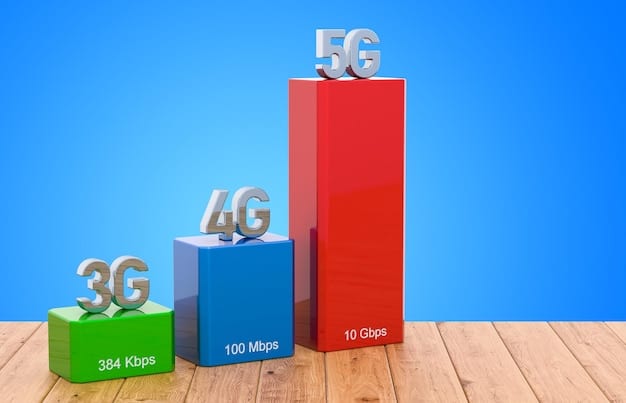5G and Esports in the US: A Data-Driven Look at Performance Impact

The Impact of 5G on Esports Performance in the US: A Data-Driven Analysis reveals how the technology’s low latency and high bandwidth are poised to revolutionize competitive gaming, offering enhanced player experiences, spectator engagement, and new opportunities for growth within the American esports ecosystem.
The rollout of 5G in the US promises to revolutionize several sectors, and esports is no exception. The promise of lower latency, higher bandwidth, and increased reliability could fundamentally change how games are played and watched.
The Promise of 5G for Esports
5G technology is expected to bring a new level of connectivity and performance to various industries, including gaming. For esports in the US, this means potentially transformative changes in how games are played, streamed, and experienced by both players and fans.
Reduced Latency and Improved Responsiveness
One of the most significant benefits of 5G is its reduced latency, the delay between an action and the response. For professional gamers, even milliseconds can make a difference in performance.
Increased Bandwidth and Enhanced Streaming
5G’s higher bandwidth capacity allows for smoother, higher-quality streaming of esports events. This can significantly enhance the viewing experience for fans watching remotely, enabling them to enjoy games in 4K resolution or even VR.
Here are key aspects of how 5G is poised to improve esports performance:
- Reduced input lag leading to faster reaction times.
- More reliable connections that minimize interruptions during crucial moments.
- Enhanced streaming quality, providing a better viewing experience for fans.
- Support for new gaming technologies like cloud gaming and VR esports.
In conclusion, 5G’s capabilities could elevate esports to new heights, making it more competitive, accessible, and visually appealing.
Current State of Esports in the US
The esports industry in the US is rapidly growing, attracting significant investment and viewership. Understanding the current landscape is crucial to appreciate the potential impact of 5G.

Market Size and Revenue
Esports revenue in the US has been steadily increasing, driven by sponsorships, advertising, media rights, and in-app purchases. Understanding how 5G might further boost these revenue streams is a key area of analysis.
Popular Games and Tournaments
Games like League of Legends, Counter-Strike: Global Offensive, and Overwatch are staples in the US esports scene. These titles benefit significantly from low latency networks.
Here’s an overview of the current esports environment in the US:
- Significant growth in revenue, with forecasts indicating continued expansion.
- Increasing viewership, drawing in both casual fans and dedicated enthusiasts.
- The rise of professional esports teams and leagues, attracting major investment.
- The emergence of new esports titles and formats, offering fresh opportunities for growth.
Overall, the esports industry in the US is thriving, providing a fertile ground for 5G to drive further innovation and growth.
How 5G Reduces Latency in Esports
Latency is the bane of every competitive gamer. 5G promises to significantly reduce this delay. But how does it achieve this feat?
The Technical Aspects of 5G Latency
5G networks use advanced technologies like millimeter waves and beamforming to transmit data faster and more efficiently. These technologies help minimize latency, resulting in quicker response times.
Impact on Gameplay
The reduction in latency directly impacts gameplay. Gamers experience smoother, more responsive controls, allowing them to react faster and more accurately.
To understand the impact of 5G on latency, consider these points:
- 5G reduces the time it takes for data to travel between the gamer and the game server.
- Improved responsiveness allows for more precise aiming and movement.
- Lower latency results in a more seamless and immersive gaming experience.
- 5G can enable new gameplay mechanics and strategies that were previously impossible due to latency limitations.
In essence, 5G’s low latency capabilities have the potential to redefine competitive gameplay, giving players a more seamless and responsive experience.
Data Analysis: 5G Performance Metrics in Gaming
To quantify the impact of 5G on esports, it’s important to look at real-world data. What are the key performance metrics, and how do they compare with previous generations of network technology?

Latency Benchmarks
Studies have shown that 5G can reduce latency to as low as 1 millisecond in ideal conditions. This is a significant improvement over 4G, where latency typically ranges from 30 to 50 milliseconds.
Speed and Bandwidth Improvements
5G offers much higher download and upload speeds compared to 4G. This allows for faster game downloads and smoother streaming during esports events.
Real-World Case Studies
Examining real-world case studies provides tangible evidence of 5G’s performance benefits. These studies often involve comparing gameplay experiences on 4G and 5G networks.
Here are some data points that illustrate the impact of 5G on gaming performance:
- Average latency reduction of 70-80% compared to 4G.
- Download speeds that are 10-100 times faster than 4G.
- Improved network reliability, resulting in fewer disconnections during gameplay.
- Enhanced streaming quality, allowing for 4K resolution and higher frame rates.
These metrics underscore the transformative potential of 5G for esports, providing players and viewers with a vastly superior gaming experience.
Challenges and Considerations for 5G in Esports
While the potential of 5G in esports is immense, there are challenges that need to be addressed to fully realize its benefits. These include infrastructure limitations, cost considerations, and security concerns.
Infrastructure and Coverage
The widespread adoption of 5G requires significant investment in infrastructure, including the deployment of new cell towers and base stations. Coverage can also be limited in certain areas.
Cost and Accessibility
The cost of 5G devices and data plans can be a barrier for some gamers. Ensuring that 5G is accessible to a wide range of players is essential for promoting inclusivity.
Here are some of the challenges associated with the adoption of 5G in esports:
- Limited availability of 5G coverage in certain regions.
- High cost of 5G infrastructure and devices.
- Concerns about network security and data privacy.
- The need for standardization and interoperability across different 5G networks.
Addressing these challenges is critical for ensuring that 5G can deliver its full potential for esports in the US.
Future Trends and Innovations in 5G Esports
As 5G technology continues to evolve, new trends and innovations are likely to emerge in the esports industry. These include cloud gaming, VR esports, and enhanced spectator experiences.
Cloud Gaming
5G’s low latency and high bandwidth make cloud gaming a viable option. Players can stream games directly to their devices without needing expensive hardware.
VR Esports
VR esports offer a more immersive and engaging experience for both players and spectators. 5G’s capabilities can support the high bandwidth and low latency requirements of VR gaming.
Here are some of the future trends and innovations that could shape the future of 5G esports:
- The rise of cloud gaming platforms that leverage 5G’s capabilities.
- The emergence of new VR esports titles and leagues.
- Enhanced spectator experiences through augmented reality (AR) and mixed reality (MR).
- The integration of artificial intelligence (AI) for real-time coaching and analysis.
These trends point toward a future where 5G esports are more accessible, immersive, and interactive, creating new opportunities for players and fans alike.
| Key Point | Brief Description |
|---|---|
| 🚀 Reduced Latency | 5G significantly lowers latency, improving responsiveness in games. |
| 📶 Enhanced Bandwidth | Higher bandwidth allows for smoother, high-quality streaming of esports events. |
| 🎮 Cloud Gaming | 5G enables cloud gaming, reducing the need for expensive hardware. |
| 💰 Market Growth | 5G is expected to further boost esports revenue through sponsorships and advertising. |
FAQ
▼
5G uses technologies like millimeter waves to transmit data faster, reducing the delay between an action and the response. This enhances gameplay responsiveness and precision.
▼
Viewers benefit from higher quality streaming, reduced buffering, and the potential for immersive experiences like VR esports. This leads to a more enjoyable viewing experience.
▼
Challenges include limited infrastructure, high costs of 5G devices and data plans, and concerns about network security. Addressing these issues is vital for widespread adoption.
▼
5G’s low latency and high bandwidth make cloud gaming a viable option, allowing players to stream games to their devices without needing expensive hardware. This increases accessibility.
▼
Innovations include the rise of VR esports, integration of AR/MR for enhanced spectator experiences, and the use of AI for real-time coaching and analysis, improving the overall esports ecosystem.
Conclusion
In conclusion, the integration of 5G in esports in the US holds immense potential for transforming the industry. The technology’s low latency, high bandwidth, and increased reliability can enhance player performance, spectator experiences, and open up new avenues for innovation. While challenges remain in terms of infrastructure, cost, and security, the future of 5G esports in the US looks promising, with exciting trends like cloud gaming, VR esports, and AI integration on the horizon.





